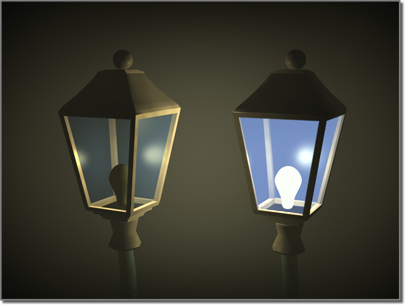Self-Illumination creates the illusion of incandescence by replacing any shadows on the surface with the diffuse color. At 100 percent, the shadows are completely replaced by the diffuse color, creating the illusion of self-illumination.

The lamp on the right uses self-illumination to brighten the bulb and the glass panes.
Unless you use environmental effects or global illumination, lights only illuminate your scene: they don't appear in the rendering. You can use self-illuminated materials on objects that represent lights to provide things like car headlights, and so on.
A self-illumination map lets you use a map to affect the intensity in different areas of the self-illuminated surface. Like many other map types, only the intensity of the map values affects self-illumination. White provides the most, while black blocks the illumination completely.
It's often a good idea to design a self-illumination map to match your diffuse map. For example, the diffuse map might have small, yellow rectangles to represent windows, while the self-illumination map consists of matching white rectangles against black to illuminate the yellow windows.